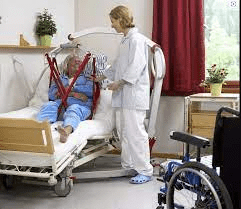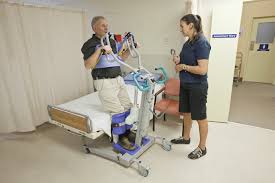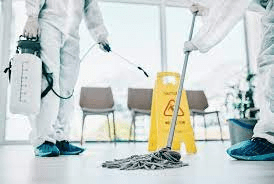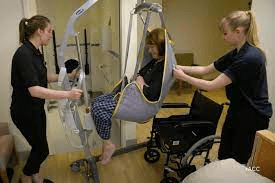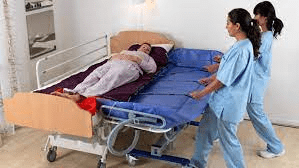In care homes, the well-being and safety of residents are of utmost importance. One crucial aspect of providing top-notch care involves using appropriate moving and handling equipment. These tools not only assist caregivers in carrying out their duties efficiently but also safeguard residents from potential injuries during transfers. In this comprehensive article, we will delve into the significance of moving and handling equipment in care homes, exploring its benefits and the variety of options available. Whether you’re a caregiver, a family member, or someone interested in the healthcare industry, this article will provide you with valuable insights and expert knowledge to ensure the safety and comfort of care home residents.
The Importance of Moving and Handling Equipment in Care Homes
Caring for elderly or disabled individuals in care homes often involves assisting them right lifting aid or lifting aids in various movements such as transferring from a care chair, bed to chair, wheelchair to shower, or repositioning in their beds. Without the proper equipment, these activities can be physically demanding for caregivers and may pose risks to the residents. Moving and lifting chairs and handling equipment addresses these challenges effectively by providing support, stability, and reducing the risk of injuries.
Enhancing Caregiver Safety and Well-Being
Utilizing Ergonomic Lifting Belts: Reducing Strain and Discomfort
Ergonomic inflatable lifting equipment and belts are a prime example of moving and lifting aid and handling equipment that benefits both residents and caregivers. These belts provide additional support and assistance during transfers, helping caregivers maintain a safe and ergonomic posture while lifting or moving residents. By reducing strain and discomfort, ergonomic inflatable lifting equipment and belts contribute to the overall well-being of caregivers, preventing long-term injuries and musculoskeletal issues.
Transfer Slings: Facilitating Smooth Transfers
Transfer aids or slings are another invaluable tool that enables smooth and safe transfers. Designed to fit around the resident’s body, these slings offer support and stability to fallen persons during lifting, reducing the risk of falls or accidents. Caregivers can use transfer aids or slings in conjunction with hoists or transfer aids, making the process’ lower lifting capacity more efficient and secure.
Ensuring Resident Safety and Comfort
Patient Hoists: A Safe and Versatile Solution
Patient hoists are indispensable equipment in care homes, particularly when transferring residents with limited mobility or who are unable to bear weight. These hoists provide a safe and secure lifting solution to transfer residents, reducing the risk of falls and injuries during transfers. With various types of patient lifts now available, such as ceiling-mounted hoists, stand-assist hoists, patient lifts, and mobile hoists, caregivers can choose the most appropriate option for each resident’s needs.
Pressure-Relieving Mattresses: Preventing Bed Sores
Pressure-relieving mattresses play a crucial role in enhancing resident comfort and preventing pressure ulcers or bed sores. These specialized mattresses distribute pressure evenly across the floor bed, reducing the risk of skin breakdown and improving overall comfort during prolonged periods of lying down.
Promoting Resident Independence
Mobility Aids: Supporting Independent Movement
Promoting resident independence is essential for their emotional well-being and self-esteem. Mobility aids such as walking frames, canes, and rollators allow residents to move around with increased confidence and autonomy. Care homes equipped with various mobility aids empower residents to engage in social activities, improving their quality of life.
Assisted Transfer Devices: Encouraging Self-Help
Assisted transfer devices like sit-to-stand lifts empower residents with some degree of mobility to participate actively in transfers. These devices offer support and assistance, encouraging self-help and independence during daily activities chair transfers.
Addressing Specific Resident Needs
Bariatric Equipment: Catering to Plus-Sized Residents
Care homes must cater to residents of varying ranges of different body sizes and shapes. Bariatric equipment, specifically designed for plus-sized individuals, ensures their safety and comfort during transfers and movements. From bariatric hoists overhead patient lifts to specialized beds, these equipment solutions address the unique needs of larger residents.
Dementia-Friendly Furniture: Creating Safe Environments
For residents with dementia, the care home environment plays a significant role in promoting their safety and well-being. Dementia-friendly furniture with features like rounded edges, contrasting colors, and clear signage helps residents navigate their surroundings comfortably, minimizing confusion and potential accidents.
Evaluating Moving, Handling and Lifting Equipment Options
Consulting with Healthcare Professionals
Choosing the appropriate moving and handling equipment requires a thorough understanding risk assessment of each resident’s unique needs and capabilities. Healthcare professionals, such as occupational therapists and physiotherapists, play a vital role in this risk assessment, evaluating residents’ mobility and recommending suitable equipment for their specific requirements.
Considering Weight Capacity and Size
When selecting moving and handling equipment, caregivers must consider the weight capacity and size of the fallen person or resident using the equipment. Ensuring that the equipment can safely accommodate the resident’s weight and dimensions is essential to prevent accidents, person falls and injuries.
Prioritizing Safety Features
Safety should be the primary concern when choosing moving and handling equipment. Features like locking mechanisms, emergency stop buttons, and non-slip surfaces contribute to the overall safety and reliability of the equipment.
Moving and handling equipment in Care Homes: Training and Education for Caregivers
Comprehensive Training Programs
For caregivers to utilize moving and handling equipment effectively, comprehensive training programs are necessary. These programs should cover proper lifting equipment usage, lifting equipment safety protocols, lifting equipment regulations, and techniques to minimize the highest risk amount of injuries during transfers.
Continuous Skill Development
As new equipment and techniques emerge, caregivers should engage in continuous skill development to stay up-to-date with best practices in moving and handling. Attending workshops and seminars can enhance their expertise and enrich the quality of care provided.
Maintaining and Inspecting Equipment
Regular Maintenance Checks
To ensure the longevity and functionality of moving and handling equipment, regular maintenance checks are imperative. These checks should include inspecting for wear and tear, testing mechanical components, and addressing any issues promptly.
Implementing Equipment Cleaning Protocols
Maintaining a clean and hygienic environment daily moving around is crucial in care homes. Implementing equipment cleaning protocols helps prevent the spread of infections and ensures that moving and manual handling of equipment remains in optimal condition.
Incorporating Technology and Innovation
Sensor-Assisted Devices
Advancements in technology have led to the development of sensor-assisted devices that enhance the safety and efficiency of moving and handling procedures. Sensor-equipped hoists and slings provide real-time data, allowing caregivers to adjust movements and handling tasks to ensure the resident’s comfort.
Virtual Reality Training
Virtual reality training is an innovative cost effective approach to equip caregivers with practical skills in a controlled environment. This technology allows them to simulate various scenarios, gaining experience without endangering residents’ safety.
The Importance of Manual Handling Aids Assist and Manual Handling Task
Reducing the Risk of Workplace Injuries
One of the primary benefits of manual handling aids is their ability to reduce the risk of workplace injuries. By providing additional support and assistance during lifting and moving tasks, these manual handling aids alleviate the physical strain that lifting operations put on workers, preventing common injuries such as strains, sprains, and musculoskeletal disorders.
Enhancing Efficiency in Material Handling
Manual handling aids not only contribute to worker safety but also enhance efficiency in material handling tasks. By streamlining the lifting and moving process of manual handling tasks, workers can carry out their duties more effectively, leading to increased time saving, productivity and smoother operations.
Handling Training
Material handling is a fundamental aspect of various industries, and it involves the lifting, moving, and carrying of objects. To carry out the manual handling task required to do these tasks safely and effectively, proper handling training is essential for workers. Handling training equips workers with the knowledge and skills required to enable easier to perform material handling tasks with reduced risk of injuries.
Slide Sheets
Slide sheets are invaluable tools that facilitate safe and effortless patient transfers in healthcare settings. By minimizing friction and shear forces, these innovative sheets contribute to patient comfort and safety during transfers. Standard slide sheets, disposable options, tubular sheets, and slotted sheets offer various benefits for different transfer scenarios. Proper positioning, adequate staffing, and regular maintenance are essential practices to ensure effective and safe slide sheet transfers. By incorporating slide sheets into patient care, healthcare professionals can enhance the quality of transfers and provide a more comfortable experience for patients with limited mobility.
Conclusion
Incorporating appropriate moving and handling equipment in care homes is a vital aspect of providing safe and quality care to residents. By utilizing ergonomic electric lifting chairs, belts, transfer slings, overhead patient lifts and hoists, and other equipment, caregivers can enhance their own well-being and the comfort of residents during complex transfers throughout. Mobility, lifting aids, and assisted transfer devices promote resident independence, contributing to their emotional well-being. Additionally, addressing specific resident needs with bariatric equipment and dementia-friendly furniture ensures that all residents receive the care and support they require. To make informed decisions, involving healthcare professionals in equipment selection is essential. Regular maintenance, continuous caregiver training, and embracing technological innovations are crucial steps in upholding safety standards in care homes. By prioritizing safety, comfort, and innovation, care homes can provide an enriching environment for their residents.
